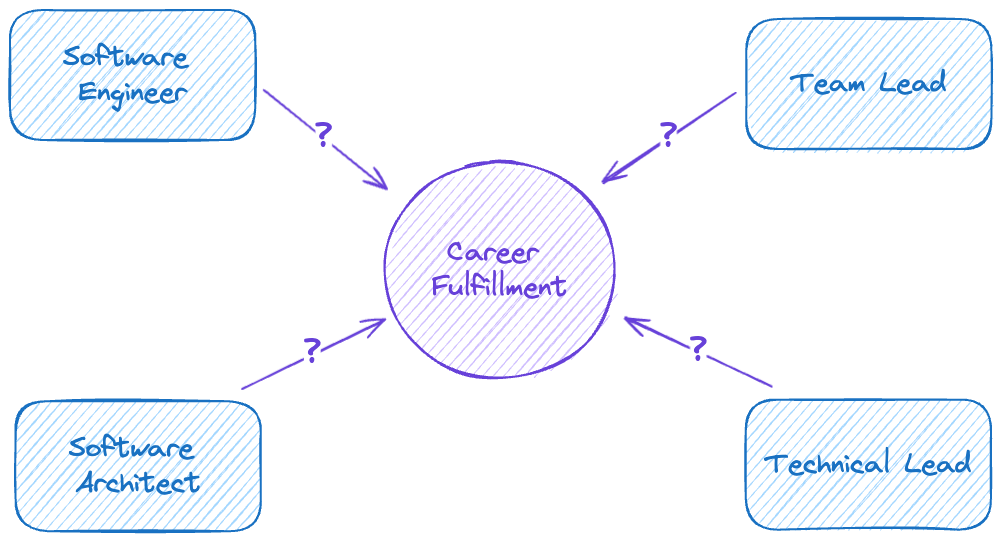This content originally appeared on Level Up Coding - Medium and was authored by CloudWay Digital Inc.

Let me share a personal story…
Some years back, as an experienced software developer working for a large multi-national corporation, I hit the proverbial wall. Day in and day out, it was the same old grind — coding for API integrations, sitting through endless scrum meetings, dealing with data migrations, code reviews, and performance evaluations. Even something as exciting as rewriting a whole product from scratch with cutting edge technologies left me wanting something different.
At that time, there weren’t any (at least not that I had heard off) career coaches for software developers who could help me navigate my career.
There were also no comprehensive resources that explained how software developers/engineers can progress in their careers to a role of a software architect or otherwise.
I wanted more out of my career — on all fronts. More interesting work. Better financial upside. More ownership and decision making power.
I wanted something more fulfilling — I wanted work that got my creative juices flowing, promised better payoffs, and gave me a real sense of ownership and accomplishment. I wanted to be the driving force behind a large project from start to finish — brainstorming requirements, hashing things out with stakeholders, and shaping the architecture.
I wanted to fulfillment in my career.
Yet, I wasn’t one of the software architects in that particular organization, and so there was no way that any of this was to happen. Or so I thought.
Then, one day, I attended a vendor conference about the latest trends in Cloud and AI technology. There, during one of the sessions, I got an inkling of an idea. That idea revolved around using AI for something very specific that my company was struggling with. It was early on in the days of what many now call “the AI bubble”. Yet, it was a fairly well grounded idea that could really benefit from some specific AI capabilities for resolving a set of well defined problems. After mulling it over for a couple of days, I knew, more or less, how I could implement it and by doing so, save my company millions of dollars per year.

Long story short, I created a brief “elevator pitch” business proposal and marched to our director of Product. The director liked the idea and was willing to support me. What happened after was that I continued evangelizing the organization and getting project managers, product owners, and entire teams on board.
I became the de-facto lead architect on that project — building a POC and eventually demoing it to the CTO.
The project was halted after a while due to budgeting constraints and a shift in company direction, but that didn’t matter. The lessons that I drew still serve me to this day, and I have been successfully applying them in furthering my career from that point on.
(For those interested — I’ve documented all of these hard-learned lessons in my Unlocking the Career of Software Architect guide.)
Below, you will find a distilled version of the framework that I used in that project, and that I honed and perfected over the years.
Who Is This Framework For?

This 3-step framework is tailored for any technical individual contributor — software developers/engineers, architects, and technical leads. It’s particularly valuable for those experienced individuals within the industry who had found themselves at a career crossroads, feeling stagnant or uncertain about their trajectory.
The framework outlined below aims to provide clarity and direction, helping you break free from inertia and chart a path towards career fulfillment and success.
This framework is most effective when you have a degree of autonomy in your role or organization. While not a strict requirement, having established credibility and trust within your current environment enhances its relevance. However, it can also be adapted to new roles or situations with some adjustments in approach and expectation-setting.
Let’s get to it!
The Framework

Step 1 - Clarify
Many software engineering professionals struggle with clarity regarding their career goals. To set yourself up for success, take time to articulate what success means to you. Consider your ideal role and rank the importance of different career dimensions using the provided matrix.
Career Dimension Matrix

Hence, the four dimensions are:
- Financial
- Flexibility
- Interesting Work
- Authority
Be honest in filling out the above. The more honest you are with yourself, the better you will be able to position yourself for success.
Note that there may be other dimensions of a role that are of importance to you. Feel free to add these in as well. What we have above are simply the ones that I hear about the most when asking software engineers of what is important to them.
Now, digging deeper into these dimensions, we can expand on them as follows:
Financial: Growing financially within a role typically revolves around either being promoted or focusing on work that provides the most value to the organization. Also, the latter is a foundation of the former. Identify such work, and you will know in which direction to move for securing your success.
Flexibility: Many are looking for more flexibility at work — in terms of working remotely, a 4-day workweek, non-standard working hours and so forth. Often, some kind of flexibility is offered “by default”. However, it is also a matter of establishing yourself first and gaining trust before you get access to that kind of flexibility.
Interesting Work: If you want to work on the latest and greatest, you need to keep an ear out for what is happening in your organization. What initiatives are abuzz? What are stakeholders planning for the short, mid, and long term? What is the company strategy? Even if there are no existing options, you could be the one to bring something to the table that no one else had thought of. As a bonus — doing so also helps in the Financial dimension.
Thought Leadership: Building authority and thought leadership requires you to expose your knowledge to others. It requires your willingness and openness to guide, mentor, coach, and teach. Presentations, lunch & learns, knowledge transfers, 1:1 mentorship are all ways of building thought leadership to cement your role and authority within an organization.
Step 2 - Position

After clarifying your goals, identify opportunities for growth within your current role or organization. Whether it’s advancing financially, achieving work-life balance, engaging in interesting projects, or building authority -deliberate action is key.
The great thing about the dimensions in the preceding section is that oftentimes, they overlap. Even if you pursue multiple (or all) of these aspects, you can still be successful. That said, you have to be very cognizant and mindful of how you approach each of them, where it is they overlap, and where they diverge.
As you’re thinking about those aspects of the role that are important to you, also consider what initiatives within your organization that you should be focusing on to enable these aspects.
List those initiatives.
Now, here’s the key point that most don’t understand.
You will, in all likelihood, find that you don’t really know what initiatives are happening within your organization or even within your immediate team!
This is what is called an “Unknown Unknown”. You just don’t know what’s out there.
That’s the time to talk to others — stakeholders, other teams, your manager, your director. The key point is that you need to get the lay of the land in terms of opportunities and possibilities within your organization that can bring you closer to your career goal(s).
If you don’t ask — you don’t know.

It helps to schedule a 1:1 meeting with one or two people per week, express your interest in what they do, and ask questions. After a few of those 1:1’s, you will have a list, however long, of projects and initiatives.
Go through that list and identify projects that are:
- Providing high value to the company
- You are interested in
- You have a high degree of confidence that you can contribute
The projects that fulfill all three of those — are prime candidates.
You can even assign a ranking/weight system to those initiatives based on those three (or other) attributes above.
One such ranking system is the weighted scoring method frequently used in Agile methodologies to decide what products or features to work on.
Another way of selecting an initiative is reflected in the Venn diagram above. The idea is that you would be selecting those initiatives where there is at least some overlap between what you want to be doing, what your organization requires, and what the industry overall is interested in.
The intersection of all three is where the highest value initiatives will be positioned. It’s a simplified version of the Ikigai model frequently used in manufacturing and now in product engineering as well.
Step 3 - Implement

This is the most concrete step of the framework. It is where you execute on the things you’ve identified in the previous steps. Implementation involves structure and organization. It also means being deliberate with your actions.
Moreover, implementation needs to be both measurable in terms of the value provided as well as flexible enough to enable learning from any failures and doubling down on success.
To make things concrete, implementation can be anything from building an application, designing a system, delivering a product, reaching a milestone, training a team, and a plethora of other activities. It all depends on the direction you’ve set for yourself in Step 2 above.
The key is to pivot into those initiatives that are positioned in that overlap of value you’ve identified in Step 2.
Another key of implementation that is missed by many is to be visible with your progress and achievement. After all, your contribution may be amazing, but stakeholders and management have to be aware of that for you to receive recognition and reap the rewards.
Summing Up

In conclusion, the 3-step framework above offers a strategic roadmap for career advancement, empowering experienced software professionals to overcome stagnation and achieve their career aspirations.
The first step (Clarify) is about identifying what it is that you are focusing on and what is driving you. This is where you identify which goal you will aim at.
The second step (Position) is all about setting on the right course based on what you have identified to be your drivers. This is where you choose the concrete initiatives to start or to follow. This is where you aim at the goal that you have identified.
The third (Implementation) step is where you strategize, map out, and execute those activities that are aligned with achieving the initiatives identified in the previous step above. This is where you actually start moving in the direction of your goal — course correcting where needed.
Hopefully this framework helps orient you in the right direction insofar as your career goes.
I’m Yakov — principal software architect and career coach for experienced software engineering professionals.
You can find me at https://www.developer.coach/ or https://cloudwaydigital.com
My guide on how to become a software architect is here: https://www.cloudwaydigital.com/unlock-your-career-as-software-architect
How to Propel Your Software Engineering Career Forward With 3 Actionable Steps was originally published in Level Up Coding on Medium, where people are continuing the conversation by highlighting and responding to this story.
This content originally appeared on Level Up Coding - Medium and was authored by CloudWay Digital Inc.
CloudWay Digital Inc. | Sciencx (2024-07-09T15:35:01+00:00) How to Propel Your Software Engineering Career Forward With 3 Actionable Steps. Retrieved from https://www.scien.cx/2024/07/09/how-to-propel-your-software-engineering-career-forward-with-3-actionable-steps/
Please log in to upload a file.
There are no updates yet.
Click the Upload button above to add an update.
